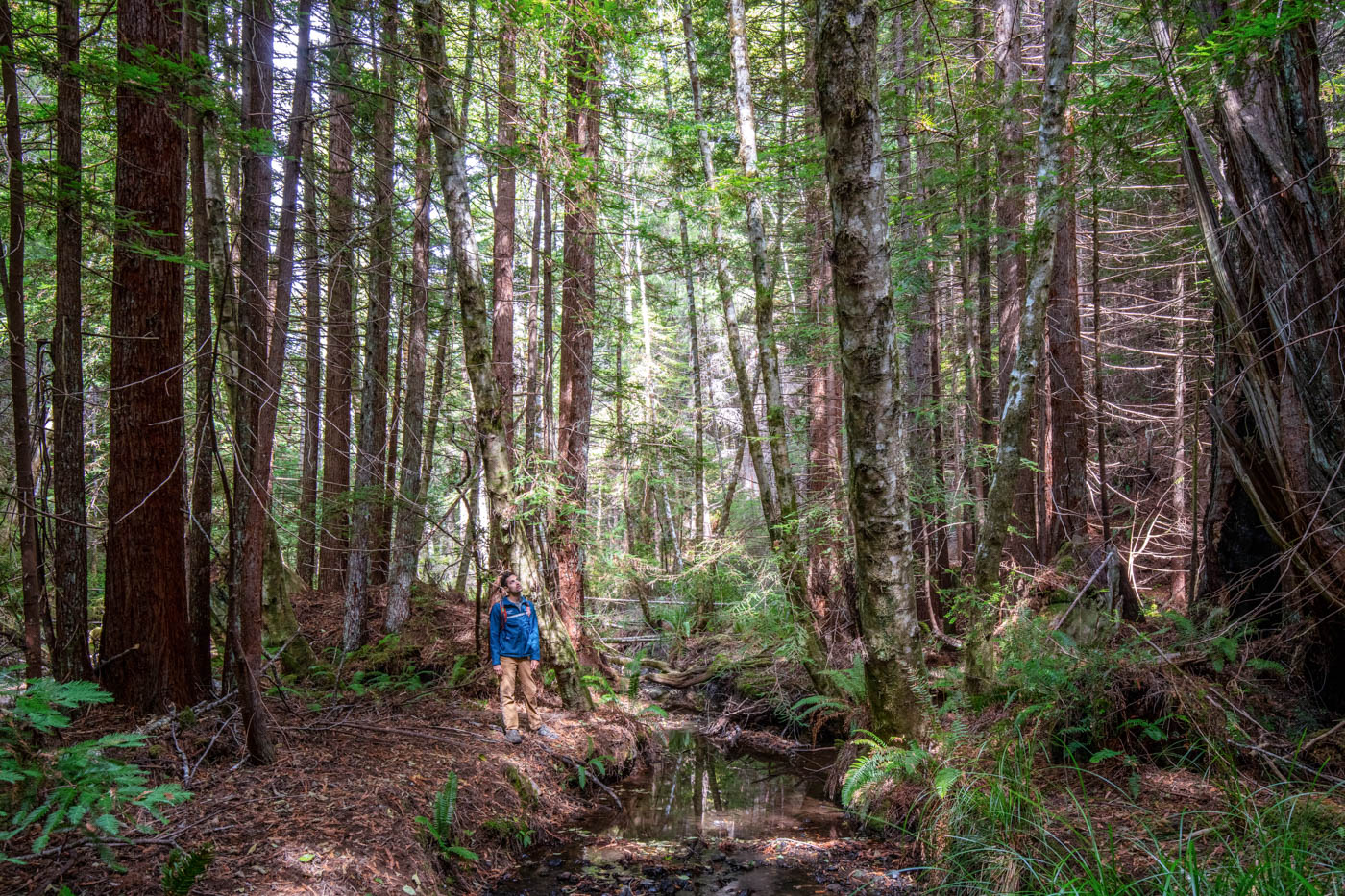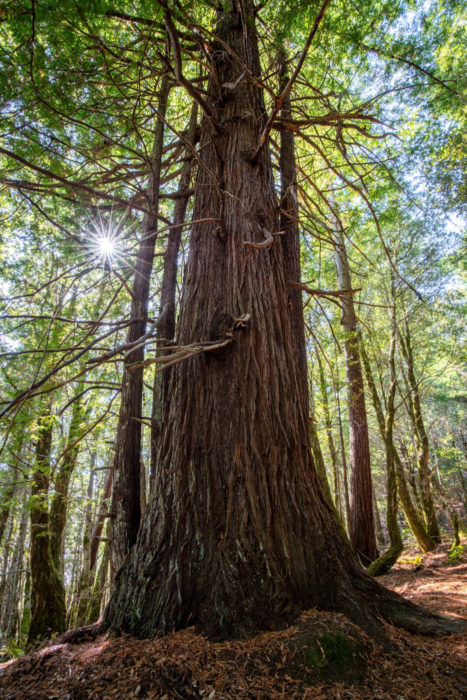
The InterTribal Sinkyone Wilderness Council is a nonprofit consortium of 10 federally recognized tribes with deeply rooted cultural connections to the lands and waters of traditional Sinkyone and neighboring tribal territories. The Sinkyone Council consists of Cahto Tribe of Laytonville Rancheria, Coyote Valley Band of Pomo Indians, Hopland Band of Pomo Indians, Pinoleville Pomo Nation, Potter Valley Tribe, Redwood Valley Little River Band of Pomo Indians, Robinson Rancheria of Pomo Indians, Round Valley Indian Tribes, Scotts Valley Band of Pomo Indians, and Sherwood Valley Rancheria of Pomo Indians.
In 1986, tribes formed the InterTribal Sinkyone Wilderness Council with the goal of acquiring a 3,845-acre property through a divestiture of 7,100 acres by Georgia-Pacific Corporation. In 1997 the Sinkyone Council purchased the property, now known as the InterTribal Sinkyone Wilderness, from the Trust for Public Land with a grant from the Lannan Foundation and contributions from the public. Under the Council’s ownership, the land is permanently protected from development, commercial harvesting, and fragmentation, while also serving as a place to revitalize traditional cultural lifeways and stewardship practices.
Tc’ih-Léh-Dûñ is pronounced tsih-ih-LEY-duhn and translates to “Fish Run Place.”
In the words of Bears Ears area Indigenous women Elouise Wilson, Mary R. Benally, Ahjani Yepa, and Cynthia Wilson, rematriation refers to “nurturing the cycle of life, restoring our relationships with the land and our nonhuman relatives.” It also refers to the return of lands to tribes; the term is repurposed from the word repatriation, to recognize and honor traditional matriarchal and matrilineal societies.
According to the Land Trust Alliance, a conservation easement is a legal agreement between a landowner and a land trust or government agency that permanently limits uses of the land to protect its conservation values. It allows a person or group to continue to own and use their land and to sell it or pass it on to heirs. No matter how many times the land gets sold down the line, the protections stay with it forever.
The conservation easement for Tc’ih-Léh-Dûñ prohibits commercial timber harvesting and development. The land must be managed according to a Habitat Management Plan approved by the U.S. Fish and Wildlife Service. That plan requires mapping the land’s vegetation and wetlands, and surveying for the presence of northern spotted owls, marbled murrelets, and foothill yellow-legged frogs every few years.
The easement requires that the Sinkyone Council remove invasive plants as necessary. It also allows but does not require foresting thinning and other restoration work. The land and the Sinkyone Council will determine the need for such activities.
The InterTribal Sinkyone Wilderness Council will be assessing the land’s stewardship needs. Logging ceased on the property 50 years ago, and there are many large second-growth trees that are already exhibiting late-seral characteristics, including complex crowns and furrowed bark, meaning they are on their way to becoming healthy old-growth trees.
There has never been, nor will there be any public access. The land is very remote and contains sensitive habitat for the Endangered Species Act–listed marbled murrelet, northern spotted owl, coho salmon, and steelhead trout. Additionally, the conservation easement prohibits development, so public access infrastructure is not possible.
The conservation easement prohibits commercial timber harvesting in perpetuity. Thinning may be conducted as needed to promote the health of the forest.
The League secured $3.55 million from Pacific Gas & Electric Company (PG&E) to fully fund the acquisition, along with an endowment through a Habitat Acquisition and Management Agreement. The agreement was developed to meet PG&E’s 30-year conservation goal for the northern spotted owl and the marbled murrelet.
The League sees California tribes as natural partners in land conservation and will always consider partnerships that can support tribal capacity to acquire and permanently steward lands. We need to do our part to help ensure that tribal communities have the resources that they need to sustain their communities and protect the long-term health of the forest. Building partnerships and capacity to support tribal ownership and co-management is a League priority and a long-term process.
To support the InterTribal Sinkyone Wilderness Council, visit Sinkyone.org to learn more about their work. The Sinkyone Council has expressed that donating through their website is a tangible way that people can express willingness to support and be part of their Indigenous land and ocean protection work.
Indigenous cultural lifeways and traditional knowledge systems represent unique ways of relating to ecosystems, based upon Indigenous law and the law of nature—which, when carried out, help ensure biological diversity and abundance. According to an April 2021 United Nations policy brief, while Indigenous Peoples represent just 5% of the world’s population, they effectively manage approximately 20-25% of the Earth’s land surface in areas that hold 80% of the planet’s biodiversity and about 40% of all protected lands and ecologically intact landscapes.
The 30×30 Initiative is a commitment by tribal nations, state and federal governments, conservation organizations, and others to protect and conserve at least 30% of U.S. lands and oceans by 2030 through locally led initiatives. It is important that people understand these lands and waters all are within the traditional territories of tribal nations. According to the Sinkyone Council, these are cultural landscapes and seascapes that tribal nations have known, cared for, and communicated with for millennia. They represent a vast array of places with which tribes have retained and are revitalizing deep and abiding cultural relationships.
Tribal nations are at the forefront of addressing climate, conservation, and wildlife crises through their engagement in 30×30 and related efforts. As prominent leaders in land and water protection, the League and the Sinkyone Council are helping advance the emerging 30×30 effort in California. Championed by tribal leaders, the Biden-Harris Administration, Interior Secretary Deb Haaland, California Governor Gavin Newsom, and California Natural Resources Secretary Wade Crowfoot, 30×30 provides the potential for new pathways that respectfully and effectively address the planet’s conservation, climate, and wildlife crises. To learn more, visit Tribal Nations and the 30×30 Initiative to Protect Nature.
